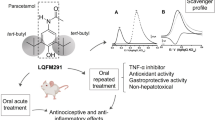Abstract
Fenbufen [3-(4-biphenylylcarbonyl)propionic acid] was shown to be an orally and parenterally effective nonsteroidal antiinflammatory analgetic and antipyretic agent in animals. Like clinically useful drugs (aspirin, phenylbutazine and indomethacin) it has potent antiinflammatory activity in a wide spectrum of laboratory tests in mice, rats, guinea pigs, and dogs and was of particular interest since it appears to have high analgetic efficacy and a long duration of antiinflammatory and analgetic action. While shown to have ulcerogenic potential in rats at toxic doses, it appeared to have a superior margin of gastrointestinal safety in treatment of dogs with urate synovitis. Evidence was also presented to show that BPAA (4-biphenylacetic acid), a metabolite of fenbufen, has a similar profile of antiinflammatory activity, although appearing to produce slightly more gastrointestinal injury. It appears that BPAA may be the agent responsible for at least part of fenbufen's pharmacologic effects. The data presented suggest that fenbufen has the potential to be used safely and effectively to provide relief for patients with inflammatory disease.
Similar content being viewed by others
References
Scherer, R.A. 1974. Aryl and heteroarylcarboxylic acids.In Antiinflammatory Agents, Chemistry and Pharmacology, Vol. I. R. Scherer and M. Whitehouse, editors. Academic Press, New York, 45.
Juby, P.F. 1974. Aryl and heteroarylalkanoic acids and related compounds.In Antiinflammatory Agents, Chemistry and Pharmacology, Vol. I. R. Scherer and M. Whitehouse, editors. Academic Press, New York, 91.
Shen, T.Y., E.A. Ham, V.J. Cirillo, andM. Zanetti. 1974. Structure-activity relationship of certain prostaglandin synthetase inhibitors.In Prostaglandin Synthetase Inhibitors. H.J. Robinson and J.R. Vane, editors. Raven Press, New York, 19.
Gryglewski, R.J. 1974. Structure-activity relationships of some prostaglandin synthetase inhibitors.In Prostaglandin Synthetase Inhibitors. H.J. Robinson and J.R. Vane, editors. Raven Press, New York, 33.
Winter, C.A., E.A. Risley, andG.W. Nuss. 1962. Carrageenin-induced edema in hind paw of the rat as an assay for anti-inflammatory drugs.Proc. Soc. Exp. Biol. Med. 111:544.
Winder, C.V., J. Wax, V. Burr, M. Been, andC.E. Rosiere. 1958. A study of pharmacological influences on ultraviolet erythema in guinea pigs.Arch. Intern. Pharmacodyn. 116:261.
Newbould, B. 1963. Chemotherapy of arthritis induced in rats by mycobacterial adjuvant.Br. J. Pharmacol. Chemother. 21:127.
Ward, J., andR.S. Cloud, 1966. Comparative effect of antirheumatic drugs on adjuvant-induced polyarthritis in rats.J. Pharmacol. Exp. Ther. 152:116.
McCarty, D.J., Jr., andJ.A. Faires. 1963. A comparison of the duration of local anti-inflammatory effect of several adrenocorticosteroid esters-a bioassay technique.Curr. Ther. Res. 5:284.
Winter, C.A. 1965. Anti-inflammatory testing methods: comparative evaluation of indomethacin and other agents.In International Symposium on Non-Steroidal AntiInflammatory Drugs, International Congress Series, No. 82. S. Garattini and M.N.G. Dukes, editors. Excerpta Medica Foundation, Amsterdam, 190.
Hendershot, L.C., andJ. Forsaith. 1958. Antagonism of the frequency of phenylquinone-induced writhing in the mouse by weak analgesic and nonanalgesics.J. Pharmacol. Exp. Ther. 125:237.
Randall, L.O., andJ.J. Selitto. 1957. A method for measurement of analgesic activity on inflamed tissue.Arch. Intern. Pharmacodyn. 111:409.
D'Amour, F.E., andD.L. Smith. 1941. A method for determining loss of pain sensation.J. Pharmacol. Exp. Ther. 72:74.
Woolfe, G., andA.D. MacDonald. 1944. The evaluation of the analgesic action of pethidine hydrochloride (Demerol).J. Pharmacol. Exp. Ther. 80:300.
Eddy, N.B., C.F. Touchberry, andJ.E. Lieberman, 1950. Synthetic analgesics. I. Methadone isomers and derivatives.J. Pharmacol. Exp. Ther. 98:121.
Abdel-Galil, A.A.A., andP.B. Marshall. 1968. Phenylbutazone and histamine formation in rat glandular stomach: Its relationship to gastric ulceration.Br. J. Pharmacol. Chemother. 33:1.
Peterfalvi, M., R. Deraedt, J. Benzoni, L. Chiflot, andR. Fournex. 1975. Floctafenine, a new non-narcotic analgesic.Arch. Intern. Pharmacodyn. 216:97.
Brodie, D.A., P.G. Cook, B.J. Bauer, andG.E. Dagle. 1970. Indomethacin-induced intestinal lesions in the rat.Toxicol App. Pharmacol. 17:615.
Santos, G.W., andA.H. Owens. 1962. The effect of certain alkylating agents and antimetabolites on the primary agglutinin of rats injected with sheep erythrocytes.Blood 20:111.
Judd, K.P., andJ.J. Trentin. 1971. Cardiac transplantation in mice. II. Effect of continuous immunosuppressive therapy on the survival of H-2 incompatible allografts.Transplantation 11:303.
Louyot, P., J.N. Tamisier, andJ. Pourel. 1974. Experimentation clinique du bucloxate de calcium (804CB) en rhumatologie.Arzneim. Forsch. 24:1428.
Sunshine, A. 1975. Analgesic value of fenbufen in postoperative patients. A comparative oral analgesic study of fenbufen, aspirin and placebo.Clin. Pharmacol. 15:591.
Tolman, E.L., andR. Partridge. 1975. Multiple sites of interaction between prostaglandins and non-steroidal anti-inflammatory agents.Prostaglandins 9:349.
Chiccarelli, F.S., and H.Eisner. Personal communication.
Ferreira, S.H., andJ.R. Vane. 1974. New aspects of the mode of action of non-steroid anti-inflammatory drugs.Annu. Rev. Pharmacol. 14:57.
Molina, J., F. Chalem, andM. Pena. 1975. Fenbufen in the treatment of rheumatoid arthritis: A controlled double-blind crossover study. Abstract in the VIII European Rheumatology Congress.Scand. J. Rheum. Suppl. 8, 4.
De Salcedo, I., L.F. Arias, andB.P. Greenberg. 1975. Fenbufen, a new nonsteroidal anti-inflammatory agent: Comparison with phenylbutazone in rheumatoid arthritis.Curr. Ther. Res. 18:295.
Shen, T.Y. 1974. Nonacidic antiarthritic agents and the search for new classes of agents.In Antiinflammatory Agents, Chemistry and Pharmacology, Vol. I. R. Scherrer and M. Whitehouse, editors. Academic Press, New York, 180.
Wax, J., W.A. Clinger, P. Varner, P. Bass, andC.V. Winder. 1970. Relationship of the enterohepatic cycle to ulcerogenesis in the rat small bowel with flufenamic acid.Gastroenterology. 58:772.
Phelps, P. 1970. Polymorphonuclear leucocyte motility in vitro.Arthritis Rheum. 13:1.
Agudelo, C.A., H.R. Schumacher, andP. Phelps. 1972. Effect of exercise on urate crystal-induced inflammation in canine joints.Arthritis Rheum. 15:609.
Greaves, M.W., andJ. Sondergaard. 1970. A new pharmacological finding in human contact eczema.Arch. Dermatol. 101:659.
Snyder, D.S., andW.H. Eaglstein. 1974. Intradermal antiprostaglandin agents and sunburn.J. Invest. Dermatol. 62:47.
Tolman, E.L., J.E. Birnbaum, F.S. Chiccarelli, J. Panagides, andA.E. Sloboda. 1976. Inhibition of prostaglandin activity and synthesis by fenbufen (a new nonsteroidal antiinflammatory agent) and one of its metabolites.In Advances in Prostaglandin and Thromboxane Research, Vol. 1, B. Samuelsson and R. Paoletti, editors. Raven Press, New York, 133.
Child, R.G., A.C.Osterberg, A.E.Sloboda, and A.S.Tomcufcik. A new antiinflammatory analgesic arylalkanoic acid. 3-(4-biphenylylcarbonyl) propionic acid, fenbufen. Synthesis and structure-activity relationships of analogs.J. Pharm. Sciences. In press.
Author information
Authors and Affiliations
Additional information
U.S. adopted name.
Rights and permissions
About this article
Cite this article
Sloboda, A.E., Osterberg, A.C. The pharmacology of fenbufen, 3-(4-biphenylylcarbonyl)propionic acid, and 4-biphenylacetic acid, interesting antiinflammatory-analgesic agents. Inflammation 1, 415–438 (1976). https://doi.org/10.1007/BF00920340
Issue Date:
DOI: https://doi.org/10.1007/BF00920340




